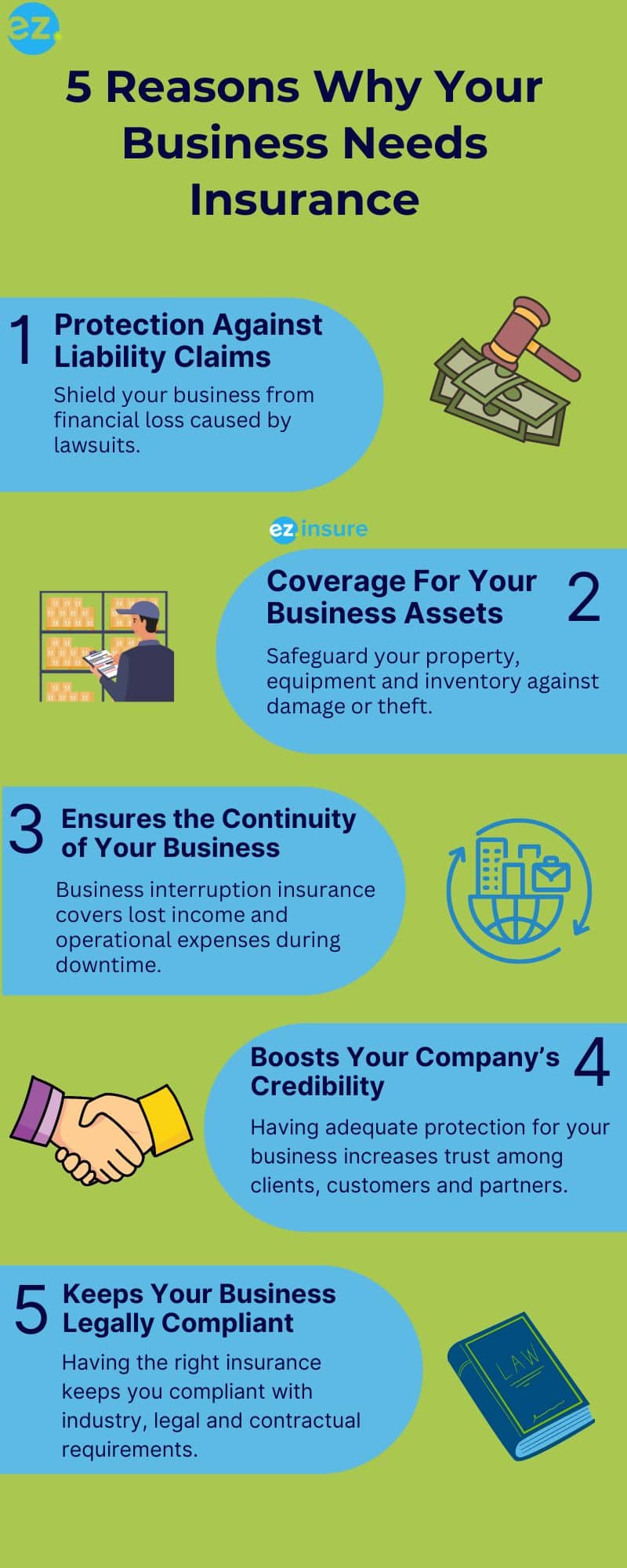Imagine putting in years of hard work, money, and passion to establish your business, only to have it all come crashing down due to an unforeseen event. It could be as minor as a lawsuit from a dissatisfied customer or as severe as a fire that destroys your office. These unexpected incidents can not only disrupt your operations, but also jeopardize your company’s future and existence. That’s where business insurance comes in. Business insurance provides a layer of security, so your organization can keep thriving for years to come.
Take natural disasters for instance. According to a study by the Federal Emergency Management Agency (FEMA), “Almost half (43 percent) of small businesses affected by disaster never reopen after the disaster…” This alarming statistic highlights the need of having business insurance in place. To help drive home the point, let’s explore 5 essential reasons why your business needs insurance to secure its existence and future.
#1 To Protect Against Liability Claims
The first reason why your business needs insurance comes down being sued. A single lawsuit, whether it’s a malfunctioning product, a slip-and-fall accident, or anything else, can result in thousands or even millions of dollars in expenses. Potential costs include things like medical expenses, legal expenses and settlement payouts. Without the proper policy in place, your company will have to pay out of pocket and oftentimes leads to bankruptcy.
To emphasize the importance of insurance, let’s explore a real-life hypothetical example. Say a small restaurant is sued because a customer spills hot coffee on themselves, and there is no warning label. This lawsuit could easily amount to over $100,000 in legal and medical fees. With no liability insurance in place, the owner could have to shut down, or go into debt in order to handle the situation. So what’s the solution?
Solution: General liability insurance protects your company from lawsuits like these by paying for legal fees, medical expenses, and even settlements, so your company does not bear the financial burden of a legal fight. This form of insurance provides peace of mind by ensuring that a single lawsuit will not destroy everything you’ve fought for.
#2 To Safeguard Your Business Assets
The second reason why your business needs insurance is to protect its physical assets. Whether it’s the office space you work out of, equipment you use, or your product inventory, it’s all valuable assets that your operation relies on. Some common disasters having the potential to destroy business assets include:
- Natural disasters (wind, rain, snow, hail etc.)
- Burglary/Robbery
- Vandalism
- Fire
Without insurance, the expenses of restoring or replacing these assets affected by one of these factors may be overwhelming or impossible. Take this story covered by Business Insurance USA. A local florist’s shop suffered major structural damage after a severe hailstorm. Much of the inventory was destroyed, and windows were shattered.
Solution: Luckily in this case, the business owner had a commercial property insurance policy which covered the costs of repairs and replacement items. Commercial property insurance safeguards the physical assets of a business, when one of the above mentioned disasters takes place. Having this protection in places helps businesses recuperate quickly to avoid long-term financial losses.

#3 To Ensure Business Continuity
Theft, accidents and natural disasters are all physically damaging, but they can also cause your business to shut down for an extended period of time. This leads us to the third reason, why your business needs insurance—so your company can stay afloat during an unexpected interruption. Think about it…if you can’t run your business, how will you pay for regular expenses like employee salaries and rent?
Solution: Business interruption insurance is crucial for businesses to protect themselves against income loss due to unforeseen events. When a disaster strikes, having a bus
iness interruption policy can be the difference-maker between needing to close down indefinitely or being able to open up a couple months later. It generally covers expenses such as:
- Lost revenue.
- Ongoing expenses.
- Costs associated with moving to a temporary location.
#4 To Build Trust and Credibility
In any industry, it’s important to have a credible and trustworthy reputation. Clients, consumers, and partners want to know that they are working with a reputable business. Otherwise, they’ll likely do their own research and work with one of your competitors instead. A great way to bolster your organization’s image is by having adequate insurance coverage. Safeguarding your business demonstrates that you’re prepared for the unexpected, letting colleagues know that you value their well-being and time.
In some industries, being properly insured has a huge impact on business dealings. For example, many individuals or businesses will not hire a contractor unless they first show proof of particular insurance coverage such as a professional liability policy. Having protection like this shows others that both parties will be protected in the case of an error or mistake. In the case of an accident or costly mistake without coverage, your business’s reputation could plummet, not to mention the expensive costs you’ll be forced to pay out of pocket. So what can you do?
Solution: Understand the risks involved in your line of work and industry, and in turn, get insured with the proper coverage. Doing so not only protects your company, but also protects clients and customers. Additionally, people will view your business as stable and trustworthy which makes it easier to form new relationships and foster long-term growth.
#5 To Ensure Compliance with Legal Requirements
In many industries, obtaining certain forms of insurance is not only a good economic move, but also required by law. Depending on your area and sector, certain coverage
types such as workers’ compensation or commercial auto insurance, are legally required. Failure to comply with these laws may result in significant fines, legal action, or possibly the closure of your business. Also, if you regularly perform contracted work, it’s vital to pay attention to contractual requirements in addition to state and federal mandates. For the failure to provide workers’ compensation insurance common penalties in many states include fines upwards of $50,000 and the suspension of business operations. So how do you avoid this happening to you?
Solution: Understand which forms of insurance are legally required for your business to be compliant. Workers’ compensation is required by law for all businesses in all states other than Texas. Additionally, coverages such as commercial auto insurance and professional liability are mandatory in many industries. With that being said, requirements are always on a case by case and state by state basis, so if you’re unsure about your business being compliant, we recommend performing your own research.
Final Thoughts on Business Insurance
While it’s tough to plan for the unexpected, it’s important to understand the most common business risks and the corresponding solutions to protect against them. To help you get started on this venture we’ve explore 5 essential reasons why your business needs insurance which includes:
- Protecting against liability claims that could result in financial devastation.
- Covering your business assets, such as your property, inventory and equipment.
- Ensuring that your company stays afloat after an unanticipated disruption.
- Increasing your organization’s credibility and customer confidence.
- Avoiding hefty legal penalties by complying with legal and contractual obligations.
Don’t let your business go unprotected for any longer. Instead, visit EZ.Insure. Our quick and easy process gives you access to a free business insurance quote, comparison tools, and a team of insurance experts to help you find a policy customized to fit your needs. Plus, EZ.Insure also has an in-depth resource library filled with dozens of informational blogs to help you become more informed about protecting your company from risks. To get started, simply enter your ZIP code at the top of the screen or call us at 855-694-0047.
FAQs
Question: Which types of insurance are required for my business?
Answer: The type(s) of insurance you need is determined by your industry, geography, and individual hazards. However, important coverages usually include general liability insurance, commercial property insurance, workers’ compensation, and professional liability insurance. A business insurance professional can assist you in designing a policy that meets your specific requirements.
Question: How much can I expect to pay for business insurance?
Answer: The cost of business insurance varies depending on the size of your company, the industry you’re in, and the coverage levels you select. For example, small businesses often spend anywhere between $500 to $3,000 per year for general liability insurance, but it’s important to speak with an insurance professional to get a more specific estimation.
Question: Can I tailor my insurance policy to meet the specific needs of my business?
Answer: Yes! Most insurers provide customisable packages, allowing you to select the specific coverages that are appropriate for your business. This flexibility guarantees that you obtain the protection you require without having to pay for coverage you don’t.





